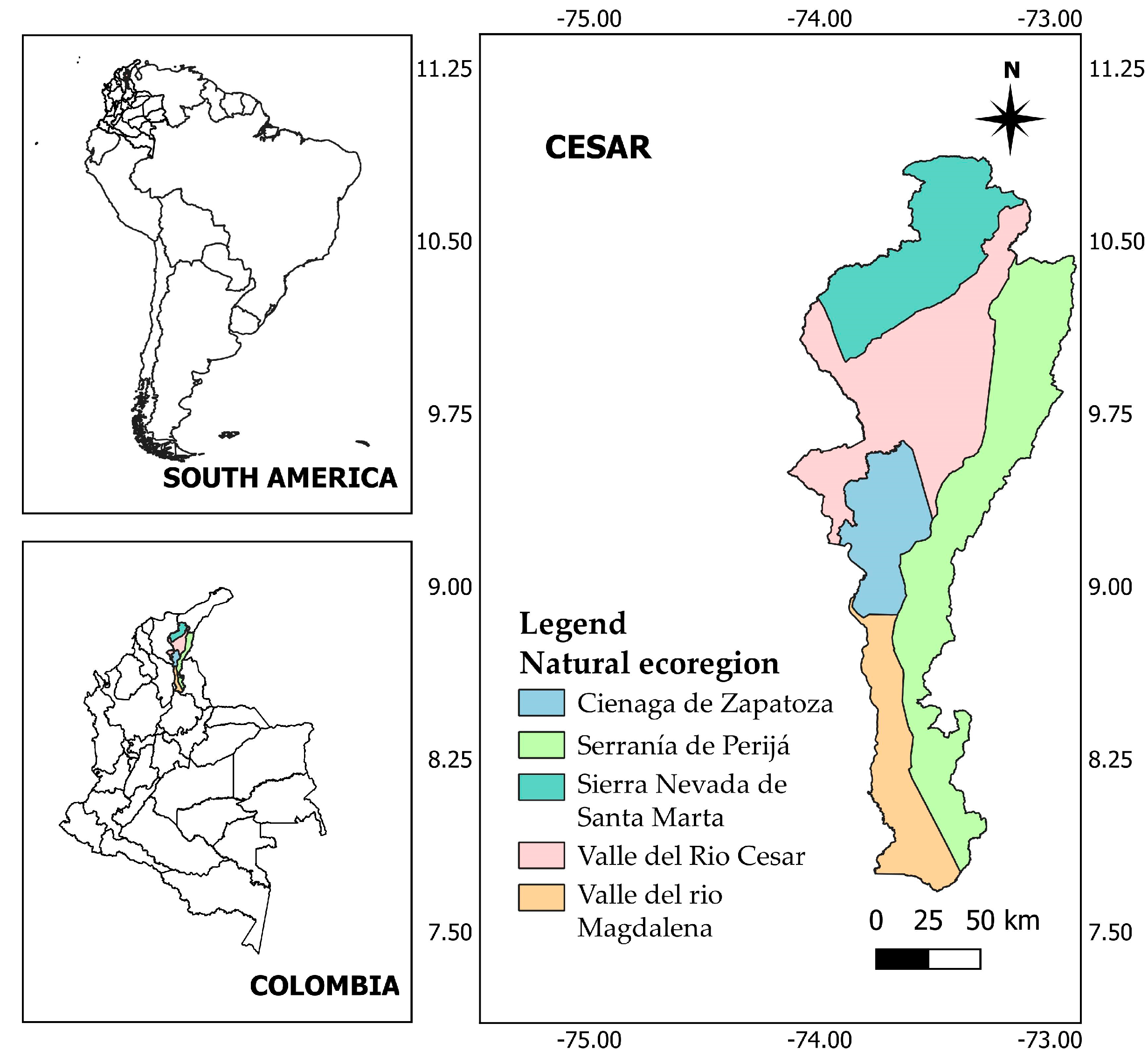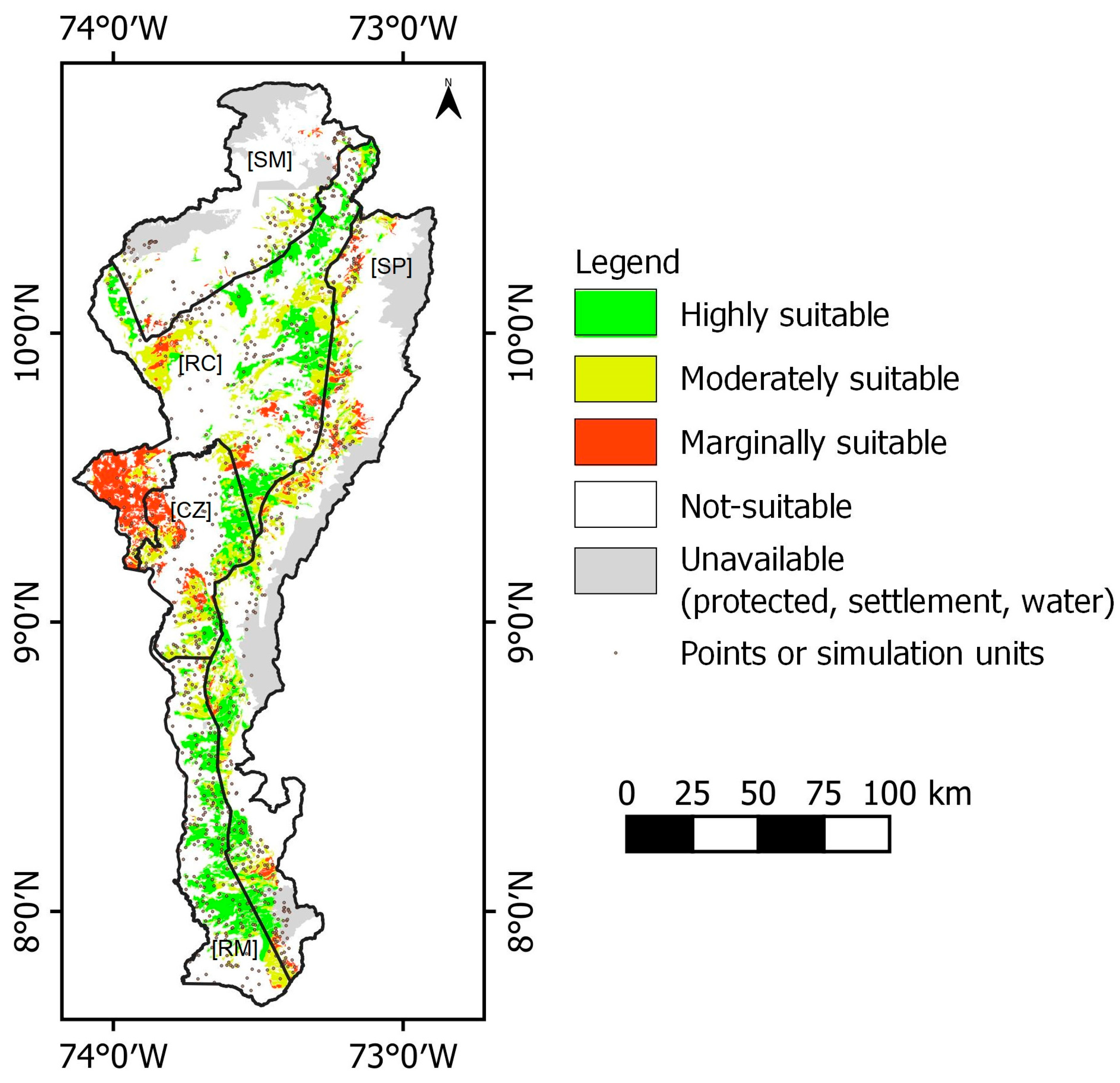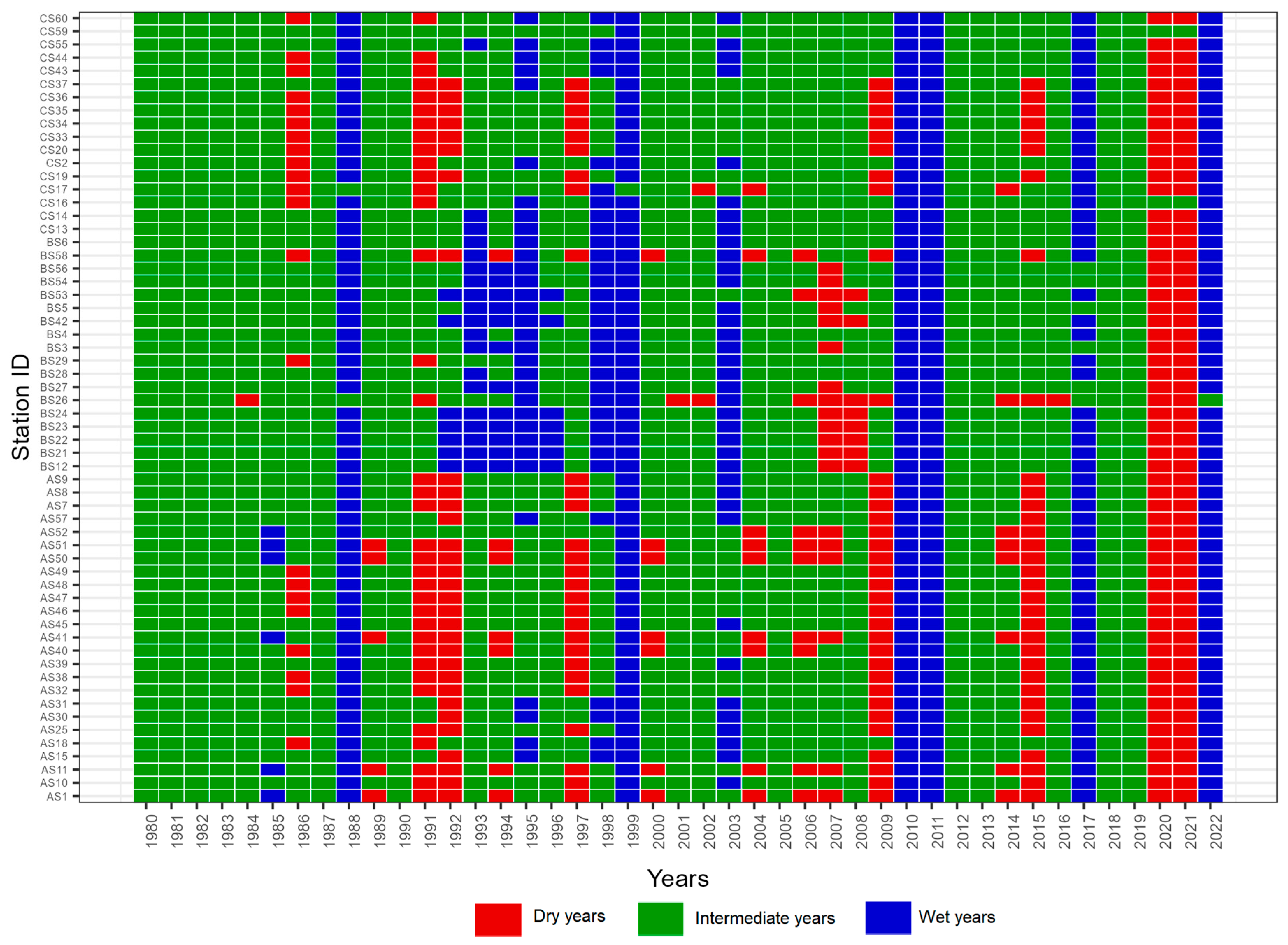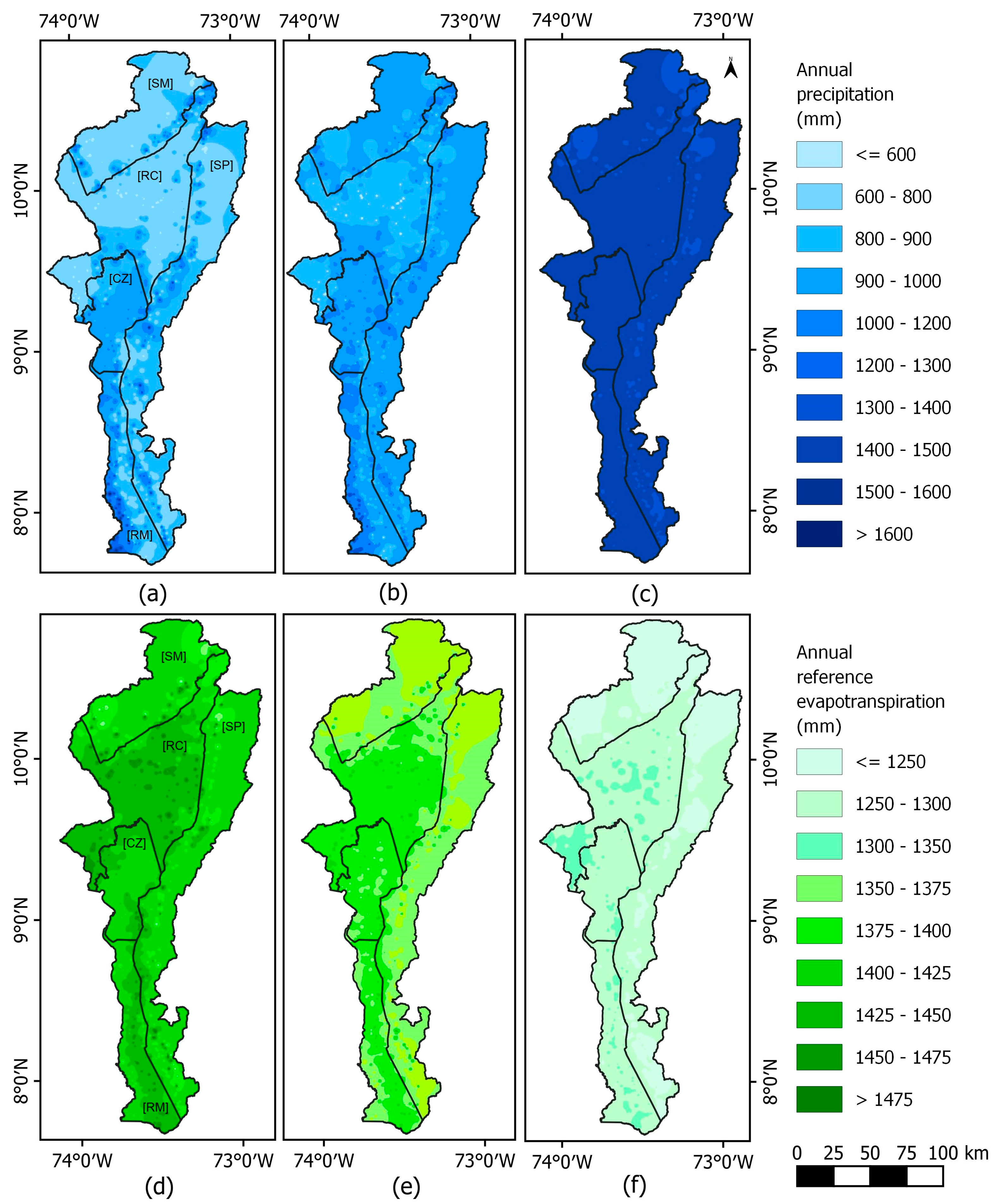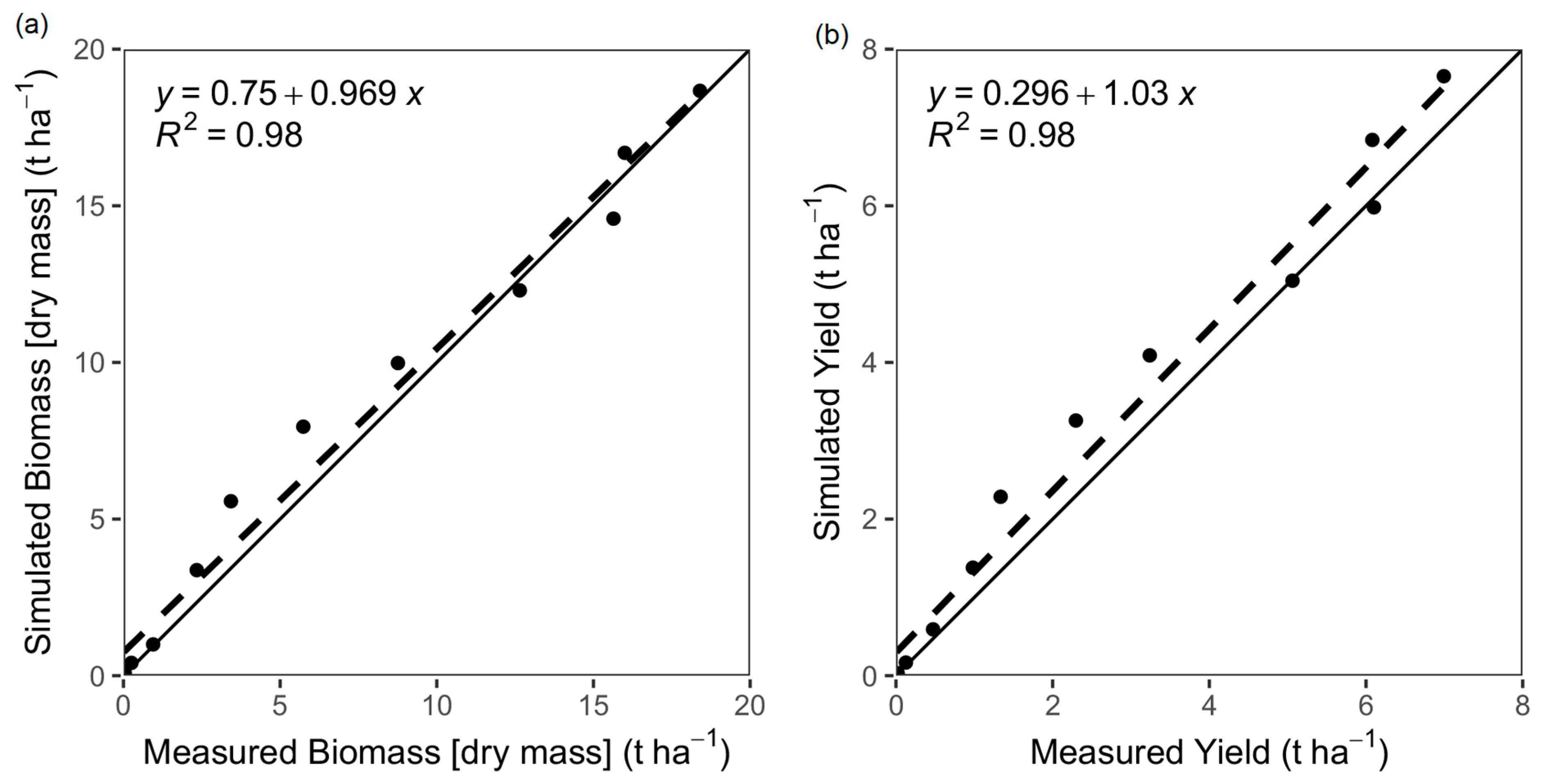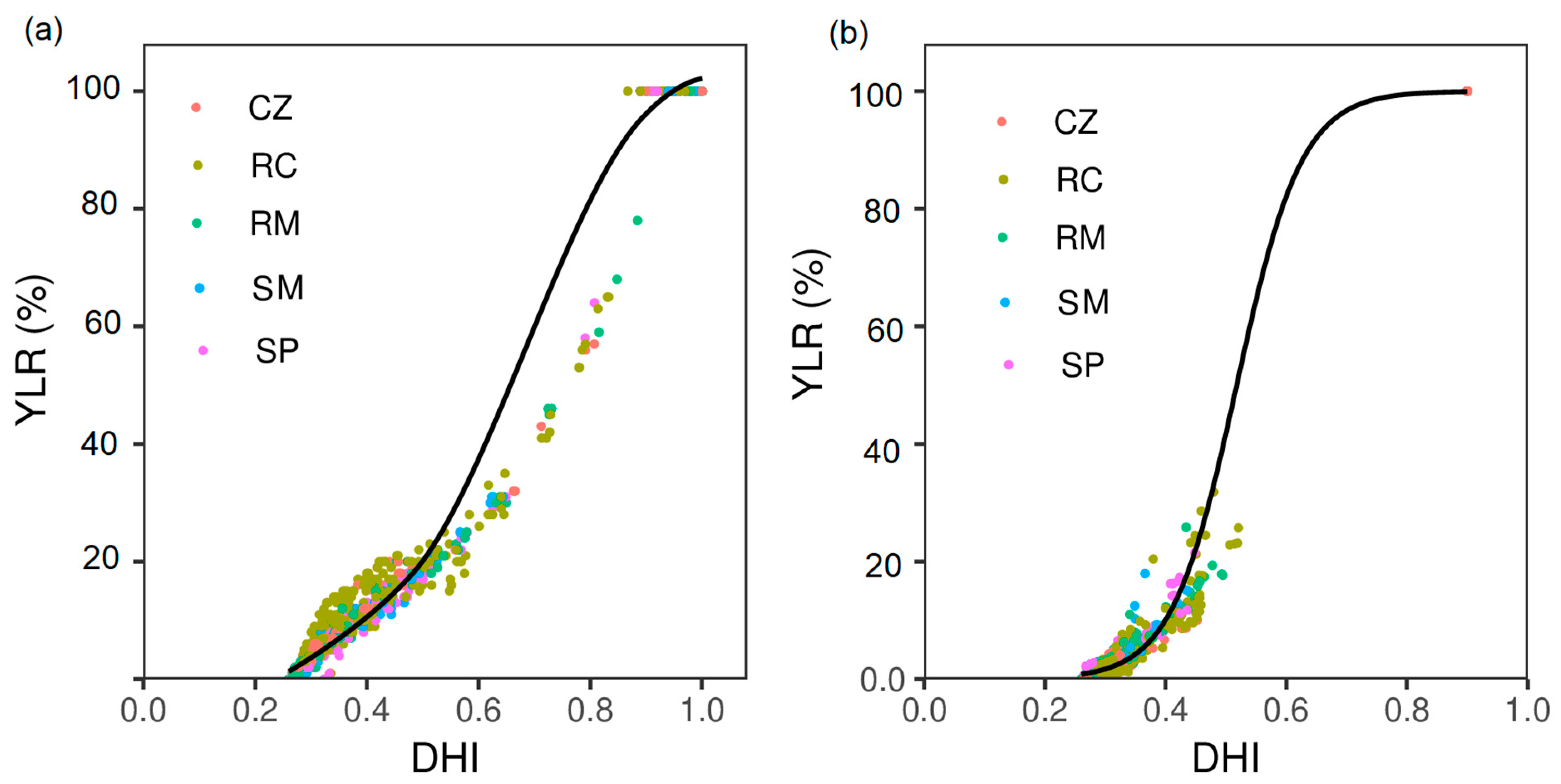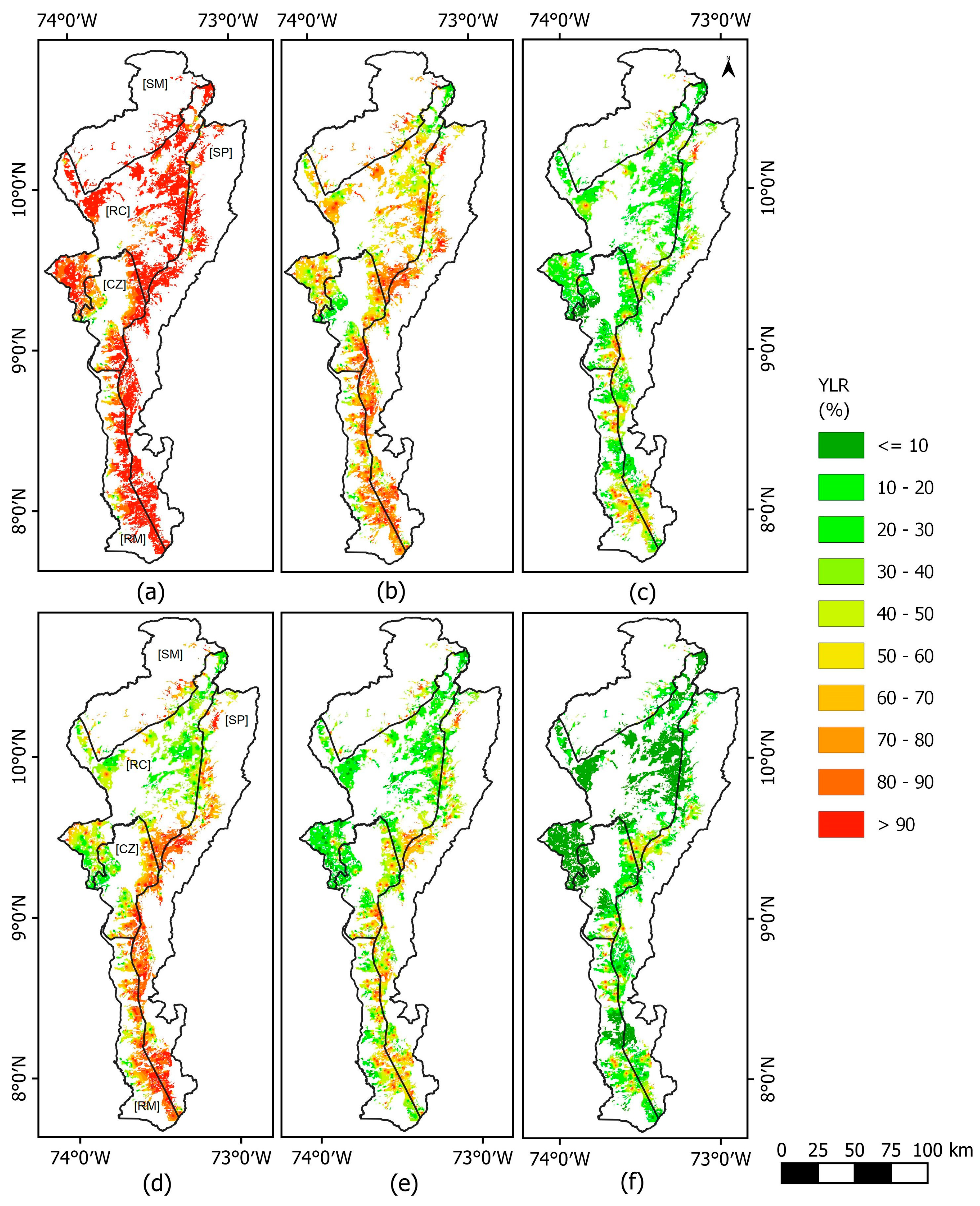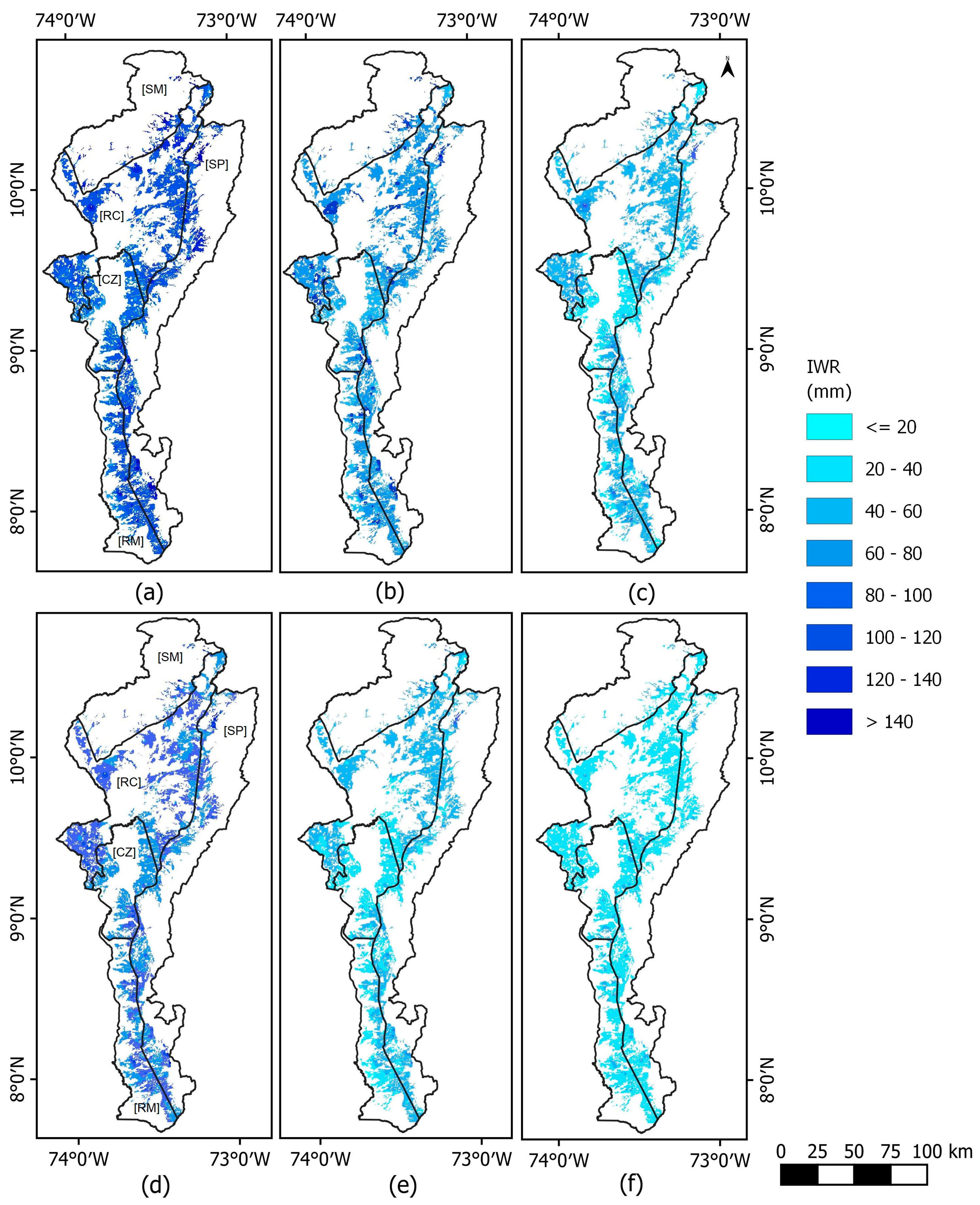1. Introduction
Maize (
Zea mays) is a significant crop cultivated worldwide, serving as a staple food and a valuable forage resource. Its rapid growth rate, nutritional value, and adaptability to a wide range of environmental conditions have made it an integral component of the global agricultural system. Over the years, global maize production has grown substantially, increasing from 313 million tons in 1971 to 1162 million tons in 2020, reflecting an annual growth rate of 3.07% [
1]. However, the projected escalation in climatic anomalies, including floods, droughts, and storms, poses a significant threat to the agricultural sector, leading to potential losses in the coming years. Notably, climate variability plays a crucial role in maize yield variability, accounting for approximately 33% of global yield fluctuations. In major food-producing regions, this percentage rises to over 60%, highlighting the strong link between climate variability and yield fluctuations [
2]. However, interannual climate variability affects agricultural production and rural livelihoods worldwide [
3], posing significant challenges for improving crop productivity and agro-climatic adaptation [
4].
In developing countries, a significant proportion of the population works in low-productivity agriculture, typically producing subsistence or selling products in local markets [
5]. These characteristics often make them less resilient to crises because they have fewer support mechanisms to mitigate the impacts of climate variability [
6]. It is expected that the demand for maize in low- and middle-income countries will double by 2050, while the impact of climate change will cause an average yield decrease of 10% if measures are not taken [
7].
The agricultural sector in tropical and subtropical American countries is particularly vulnerable to the impact of climate change and variability, as highlighted by Bouroncle et al. [
8]. In Colombia, for instance, under the RCP 4.5 scenario, it is projected that the average annual temperature will increase by 0.9 °C, 1.6 °C, and 2.14 °C by 2040, 2070, and 2100, respectively. Furthermore, one-third of the country is expected to experience a decline in precipitation levels ranging from 10% to 40%, as reported by Howland et al. [
9].
The production of maize (
Zea mays) is an essential crop in Colombia, whereby in 2021 approximately 7.6 million tons of maize was consumed in the country, with approximately 79.1% of this amount (5.7 million tons) being imported [
10]. Colombia is experiencing growing reliance on imported yellow and white maize, which poses a serious challenge to its quest for food security. This increasing dependence on foreign maize has led to a decline in self-sufficiency, currently standing at 26%, and is causing a significant setback in the country’s efforts to achieve the Food and Agriculture Organization (FAO) recommended target of 75% self-sufficiency [
11]. This situation will present a pressing challenge for the Colombian government in the coming years. Most of the corn consumed in Colombia (approximately 89.1%) is utilized for animal feed, while the remaining 10.9% is allocated for human consumption, as per the data provided by Fenalce in 2022 [
10]. Maize production in Colombia is divided into two main categories: the “technified” scheme and the “traditional” scheme. The former, which employs hybrid seeds and aims to generate profit, accounted for 58% of the total harvested area (402,567 ha) in 2021. The latter, which involves the use of native seeds and is practiced for subsistence farming purposes, accounted for 42% of the harvested area in 2021. Notwithstanding its significance, Colombia exhibits relatively low levels of average maize productivity compared with other countries. For instance, in 2021, the average maize yield in Colombia amounted to 3.6 t ha
−1, which contrasts starkly with the United States’ average maize yield of 11 t ha
−1 and the worldwide average of 5.4 t ha
−1 [
1].
Maintaining maize production in Colombia is vital for ensuring food and nutritional security and aligning with the Sustainable Development Goals (SDGs) set forth by the United Nations [
12]. Established in 2015, the SDGs aim to foster global sustainable development by addressing crucial issues such as poverty eradication, inequality reduction, and climate change mitigation. By prioritizing sustainable agricultural practices associated with maize cultivation, Colombia can contribute to SDGs such as Goal 1 (No Poverty), Goal 2 (Zero Hunger), Goal 13 (Climate Action), and Goal 15 (Life on Land). This integrated approach not only addresses immediate food security concerns but also promotes long-term sustainable development, resilience, and social progress, creating a more equitable and sustainable future.
To achieve this, improving the agricultural productivity and income of small farmers is vital [
13]. Farmers rely on irrigation to protect crops against drought and precipitation variability, which makes governmental and guild-level support crucial for reducing vulnerability to climate and economic shocks resulting from interannual anomalies. To develop regional adaptation plans, comprehensive sectoral and regional assessments of the impacts of climate change on agricultural production are necessary [
14]. Inadequate understanding of the mechanisms driving variations in crop yields can lead to incorrect actions and potentially disastrous economic consequences. In the agricultural sector, exposure to a threat is represented by crop yield, whereas vulnerability is described as the degree of yield loss in relation to the expected crop yield, thus reflecting the damage to the asset (e.g., farmland) affected by a hazard. Vulnerability was expressed on a scale from 0 (no loss) to 1 (total loss) [
15]. In this context, vulnerability functions estimate the relationship between damage and the consequent loss generated by a threat according to a specified exposure.
Crop simulation models have been used to study crop responses in different environments, including semiarid, arid, subhumid, and temperate regions [
16]. An advantage of these models is that field-scale information can be extrapolated to a large spatiotemporal scale, thereby reducing time and resource limitations when analyzing the impacts of short- and long-term abiotic and biotic shocks [
17,
18,
19]. In this context, it is important to quantify the response of crop yields to extreme precipitation events and compare them with a typical meteorological year (TMY) scenario [
20,
21,
22]. A TMY consists of 12 statistically selected months from individual years and is concatenated to form a complete year, resulting in a perfect correlation between the daily values of the climatic variables which are temperature, rainfall, and radiation. The spatiotemporal irregularity of rainfall is characterized by wet and dry periods that represent the climate pattern of a region. Consecutive periods of low precipitation result in drought conditions in which many rainfed crops are vulnerable, especially during sensitive stages such as crop establishment and flowering. Conversely, prolonged periods of rainfall lead to waterlogging, which results in high soil moisture, increasing the risk of seedling diseases during the early stages of crop growth [
23].
To effectively distribute a limited amount of water during the irrigation season, it is necessary to use a methodology that can anticipate how future climatic conditions will affect crop growth and provide guidance on water distribution during the growth period. Several crop growth models, such as APSIM [
24], AquaCrop [
25,
26], EPIC [
27], CERES [
28], and DSSAT [
29], have been utilized in research focusing on the effects of climate variability and agricultural field vulnerability, resulting in the development of vulnerability curves. In this context, vulnerability curves express physical vulnerability by illustrating the relationship between the intensity of the process (i.e., threat) and the potential degree of loss of exposed elements (e.g., a particular type of crop) [
30].
Despite their popularity, the use of vulnerability curves based on positive or negative anomalies of precipitation in assessing damage to cereal crops has been little explored in the tropical and temperate zones of South America, particularly in geographic contexts where there is a scarcity of data and resources to fund field experiments. The department of Cesar, located in the Caribbean region of Colombia, was selected as the study area because of its semi-arid nature that limits the availability of irrigation water. Understanding the degree of vulnerability of maize crops based on precipitation variability is essential for the sustainability of this agroecosystem and management of water resources for agriculture in this region.
The AquaCrop crop model [
31] developed by the Food and Agriculture Organization (FAO) incorporates linear functions that relate crop yield to the ratio between actual and potential evapotranspiration during various growth stages, depending on the crop. This study selected AquaCrop as the preferred model due to its suitability in regions where water scarcity significantly affects crop productivity. AquaCrop stands out for its ability to provide the daily crop water stress index (CWSI), enabling the assessment of precipitation anomalies’ intensity. Evapotranspiration comprises soil evaporation and vegetation evapotranspiration [
32], with soil moisture (SM) playing a crucial role in this process and exerting a substantial influence. Sufficient soil moisture promotes intense evapotranspiration, while insufficient soil moisture leads to weaker evapotranspiration and higher temperatures within the vegetation canopy [
32,
33].
The CWSI is calculated as the ratio of actual evapotranspiration (mm) to potential evapotranspiration (mm), offering a standardized scale for evaluating water stress levels. This index is a valuable tool for monitoring drought conditions resulting from soil moisture deficits and farmland evaporation. Its wide application is attributed to its clear physical significance and broad applicability in assessing water stress in agricultural systems.
This study aims to assess the vulnerability of maize crop yield to varying precipitation scenarios in the Department of Cesar and identify associated risks. Specifically, we investigate the following query: “How maize cultivation in the Department of Cesar responds to different precipitation levels and what are the implications for this crop yield?” The hypothesis is that variations in precipitation, including dry, intermediate, and wet years, will result in distinct impacts on maize production, leading to varying levels of vulnerability and risk. To address this, we employ historical weather data to construct Typical Meteorological Years (TMY) representing different precipitation scenarios. The AquaCrop-OS simulated maize crop yields under diverse conditions, including rainfed and irrigated scenarios. By analyzing the simulation results, vulnerability curves and risk distributions were developed to quantify the potential losses in maize crop yield and inform effective adaptation strategies.
2. Materials and Methods
2.1. Study Area
The Department of Cesar (CD) is a political and administrative territorial unit located on the Caribbean coast of Colombia, in northern South America, between latitudes 07°41′16″ N and 10°52′14″ N, and longitudes 72°53′27″ W and 74°08′28″ W, covering approximately 22,905 km
2 (
Figure 1). CD is an important agricultural, livestock, and agro-industrial center in the country. The natural subsystem presents a mountainous topography in 43% of the territory (elevation between 300 and 5600 masl) and plains in 57% (elevation below 100 masl) of the territory. The CD is divided into five natural ecoregions: the Sierra Nevada de Santa Marta to the northwest; the Serranía del Perijá, which runs through the entire department in its eastern zone; the Ciénaga de Zapatoza covering 300 km
2 located in the center of the territory; the Valle del Río Cesar, which occupies the central part of the department and part of the Caribbean Plain; and the Valle del Río Magdalena in the southern part of the department, consisting of low, flat areas covered by dense forests. The Magdalena and Cesar Rivers, along with their tributaries, form the hydrographic network of the department. The climate of the CD is classified according to the Köppen-Geiger classification as Aw and Am [
34]. This classification indicates that the region experiences a tropical savanna climate (Aw) and a tropical monsoon climate (Am). The Aw climate is characterized by distinct wet and dry seasons, with the dry season lasting for several months. On the other hand, the Am climate is characterized by a longer wet season, with significant rainfall throughout the year. The inclusion of these climate classifications in our study is important as it helps to provide a comprehensive understanding of the climatic conditions in the CD.
The annual precipitation ranges from 1000 to 1500 mm and the average annual temperature ranges from 24 to 35 °C [
35]. The CD experiences a pluviometric climatic regime with three seasons [
36]: dry (December–March), transitional (also known as the San Juan Summer) (June–July), and rainy (April–June and August–November).
Maize is the primary cereal crop in CD and is cultivated annually in two distinct seasons. The first sowing period occurs from late March to April, while the second sowing period occurs from the third week of August to the third week of September. It is essential to highlight that the average duration of the maize crop cycle in this region is around 120 days, encompassing different stages of growth and development until the final harvest is conducted. In 2022, 14,430 ha of maize were sown in Period I, followed by 17,790 ha in Period II [
10]. The conventional farming approach yielded 2.41 tonnes per hectare of yellow maize during Period I, while the technified farming system achieved 5.25 tonnes per hectare. During Period II, the yield of yellow maize was 1.95 tonnes per hectare for the conventional scheme and 4.65 tonnes per hectare for the technified scheme.
The suitability of the areas for maize farming in CD is shown in
Figure 2, which indicates that only 27% of the total area of the region (619,689 ha) is appropriate for this crop. This area can be further classified into highly suitable (275,048 ha), moderately suitable (231,454 ha), marginally suitable (113,187 ha), and permanently unsuitable (1,355,290 ha) areas. In addition, 281,571 ha cannot be used for maize farming because they are designated as protected, settlement, or water areas [
37]. It is interesting to note that although there are numerous suitable areas, maize is cultivated in just 5.2% of the potentially suitable areas for this crop in CD.
2.2. Classification of Precipitation Year-Types
When assessing the risks associated with maize planting, it is essential to consider three possible scenarios. The first scenario occurs when the water requirements of the current season are similar to those of an average year, resulting in an intermediate-year classification. The second scenario occurs when the water requirements of the current season exceed those of an average year, leading to a dry-year classification. In this case, early water consumption may cause a significant reduction in yield due to a water deficit. The third scenario occurs when the water requirements of the current season are lower than those of an average year, resulting in a wet-year classification.
A typical meteorological year methodology adjusted for the crop growth cycle of maize was used [
20,
21,
22]. To achieve this, we determined the distribution of wet, intermediate, and dry years during the crop growth cycle within the framework of a 42-year series (1980–2022) for 60 meteorological stations distributed in the study area. The parameters used were daily reference evapotranspiration and precipitation because of their importance for irrigation requirements, as well as minimum and maximum daily temperatures because of their effects on
ET0 and the phenological development of the crop. A precipitation deficit index (
PD) (mm) was used to determine if a year was dry, intermediate, or wet (Equation (1)) [
21].
where
PD is the precipitation deficit index,
P is the accumulated precipitation, and
ET0 is the evapotranspiration reference.
Based on the methodology proposed by Leite et al. [
21], these 42 years were arranged from the highest to lowest standardized
PD (
Z) (Equation (2)).
where
PDave is the average
PD value of the series and
DS is the standard deviation.
The data were statistically analyzed to assess whether they conformed to a normal distribution and were subsequently partitioned into three distinct groups (i.e., dry, intermediate, and wet years) with equal ranges (Equation (3)). This enabled the series of years to be classified into three broad categories (Equations (4)–(6)) based on their respective moisture levels and facilitated the generation of a typical meteorological year (TMY) that accurately represented each group.
Following the methodology proposed by Dominguez et al. [
20], constructing the Typical Meteorological Years (TMY) for the intermediate, dry, and wet scenarios involved a rigorous selection of individual months that accurately represented the characteristic climatic conditions of each identified group of years. Based on the classification of years within each scenario, we created a TMY for dry years, another for intermediate years, and an additional one for wet years. This process was implemented at the spatial level in the Department of Cesar using the Python programming language.
To conduct our simulations, we utilized daily data from the constructed TMYs. These typical years served as inputs for running simulations in the Aquacrop-OS model. Aquacrop-OS is a widely used crop simulation model that allows us to assess and analyze the potential yield of maize under different climatic conditions. By utilizing the TMY data, we were able to simulate and evaluate the maize yield response to varying weather patterns represented by the different TMY scenarios. This approach provides valuable insights into the crop’s performance and assists in agricultural planning and management decisions.
Dry and wet years can be considered risk factors for agriculture. In dry years, there is a risk of drought, which can significantly affect the crop yield and agricultural productivity. Similarly, in wet years, there is a risk of excessive precipitation, which can cause flooding and damage to crops. Farmers and agricultural professionals often view dry and wet years as risk levels that must be managed and mitigated to ensure optimal crop growth and yield.
2.3. AquaCrop Model
AquaCrop is a crop growth simulation model created by the Food and Agriculture Organization of the United Nations (FAO) and is intended to assess the water productivity of crops under varying environmental and management conditions [
31]. The AquaCrop model conceptually simulates crop development by using four consecutive processes: canopy development, crop transpiration, biomass accumulation, and yield formation. The model simulates canopy development using canopy cover instead of the leaf area index (LAI). The central assumption of AquaCrop is that the accumulation of dry matter (
B) is determined by crop transpiration (
Tr) (Equations (7) and (8)).
where
WP* represents normalized water productivity,
B represents biomass,
Tr represents crop transpiration,
ET0 represents the reference evapotranspiration, and
Ca represents the concentration of CO
2 in the air.
The crop yield can be calculated as indicated in Equation (9):
where
HI0 is the reference harvest index (
HI) related to crop variety and phenology, and
fHI denotes the stress adjustment factor (e.g., soil moisture and temperature stress).
The AquaCrop model requires the following input data: meteorological data (i.e., daily values of minimum/maximum temperature, precipitation, and reference evapotranspiration); soil parameters (i.e., soil texture, water content at saturation, field capacity, permanent wilting point, and hydraulic conductivity); crop type (i.e., parameters describing crop development and growth, including heat units and/or growing degree days for crop development, canopy cover, and root depth); and management strategies (i.e., planting date, fertilization, and irrigation, including frequency and amount of water applied). The model outputs were associated with crop canopy development and yield responses to water, biomass production, and soil water content during the growing season.
Previous studies have demonstrated the capability of the AquaCrop model to simulate maize yield and water-use efficiency in semi-arid environment [
38,
39,
40]. Additionally, AquaCrop was used to estimate the spatial variability in maize yield and identify regions with high potential for maize production. Furthermore, AquaCrop is considered a useful tool for water allocation decisions and for identifying adaptation strategies that help minimize the negative effects of climate change on maize yield. In 2022, version 7.0 of the AquaCrop model was released, which is available for major operating systems such as Windows, Linux, and Mac OS. AquaCrop has been implemented in open-source code in Matlab/Octave, where it is known as AquaCrop-OS [
41], AquaCropR [
42], and AquaCrop-OSPy (ACOSP) [
43].
2.4. Data
To simulate the growth of maize crops at a spatial level, the study area was divided into 1009 simulation units derived from the General Study of Soils and Land Zoning of the Department of Cesar, which was conducted in 2014 at a scale of 1:100,000 by the Instituto Geográfico Agustín Codazzí (IGAC) [
44]. In Colombia, the IGAC maintains databases that are part of a national soil information service called the SIGA SIG. This service provides mapping information on soil mapping units and their corresponding profiles at a scale of 1:100,000. The types and sources of data required for this study are as follows.
2.4.1. Climate Data
This study employed a robust methodology for collecting and analyzing agroclimatology data in the Department of Cesar, Colombia. The data acquisition process involved utilizing a network of weather stations covering the five ecoregions provided by the Institute of Hydrology, Meteorology, and Environmental Studies (IDEAM). Quality control and filling procedures were applied to the daily temperature and precipitation data from 1980 to 2022, following the method proposed by Terán-Chaves et al. [
45]. We incorporated 60 spatial points of supplementary data from the NASA LaRC POWER [
46] (Prediction of Worldwide Energy Resource) database to enhance the climatological information. This dataset provides satellite-derived meteorological information at a spatial resolution of 0.5°. These datasets encompassed the period from 1980 to 2022 and included daily measurements of relative humidity, rainfall, solar radiation, wind speed, and direction. Reference evapotranspiration (
ET0) was calculated using the FAO-56 Penman-Monteith method [
47].
2.4.2. Soil Hydrological Parameters
A classical digital soil mapping approach was applied to map the soil properties required as inputs for the AquaCrop-OS model. This approach involved constructing a prediction function produced by an inverse distance weighting (IDW) geostatistical algorithm using ArcGIS 9.3. The spatial data used to predict the soil properties were obtained from the General Study of Soils of the Department of Cesar at a scale of 1:100,000 [
44]. The obtained soil parameters included volumetric water content (m
3 m
−3), water content at field capacity (m
3 m
−3), water content at the permanent wilting point (m
3 m
−3), saturated hydraulic conductivity (mm day
−1), soil texture (percentage of sand and clay), organic matter content (%), and density factor (dimensionless).
Figure 3 shows the soil texture patterns observed in the study area. The data revealed that clay was the most prevalent soil texture across all ecoregions, ranging from 29% to 49%. Sandy loam ranked as the second most abundant soil texture in the four ecoregions, accounting for 12% to 33% of the soil composition. However, it was absent in the Valle del Rio Magdalena [RM] ecoregion. Sandy clay loam covers a range of 1% to 24% and is more abundant in the Sierra Nevada de Santa Marta [SM] ecoregion. Loam covers a range of 10% to 23%, with the highest percentage found in the Valle del Rio Magdalena [RM] ecoregion. Clay loam ranged from 0% to 11%, with the highest percentage observed in the Serranía del Perijá [SP] ecoregion. Silty clay loam ranged from 0% to 5%, with the highest percentage found in the Valle del Rio Cesar [RC] ecoregion. The percentage of silty clay ranged from 0 to 9%, with the highest percentage found in the Valle del Rio Magdalena [RM] and Ciénaga de Zapatosa [CZ] ecoregions. Finally, loamy sand ranges from 0% to 4%, with the highest percentage observed in the Ciénaga de Zapatosa [CZ] ecoregion.
2.4.3. Crop Parameters
The AquaCrop-OS model requires 67 crop parameters obtained from validation experiments of the AquaCrop model for maize at a site scale conducted in 2022 at the Motilonia Research Center of the Colombian Corporation for Agricultural Research, located in the Department of Cesar, Colombia (10°2′ N, 73°16′ W, 339 m above sea level elevation). The yellow maize hybrid material Pioneer 30F-35, which is widely used in this region, was used for the field experiments. After adjusting the crop parameters to local conditions, a regional estimation of productivity was conducted using available historical information on maize cultivation in the Department of Cesar [
10]. Details of the crop parameters are presented in the
Supplementary Material (Table S1).
To capture the effect of changes in rainfall patterns, we simulated the achievable maize yield under three types of precipitation years (dry year, TMY, and wet year) and two different water-use strategies (irrigated and precipitation). Fixed planting dates were considered for period I (March 25th of each reference year) and Period II (August 20th of each reference year).
In this study, the open-source version of AquaCrop-OS was used. Owing to the geospatial framework of the simulations, the ‘AquaCropOS_BatchRUN.m’ script was executed in parallel using the Parallel Computing Toolbox in MATLAB. We defined 1009 (simulation units) separate sets of input files for each simulation run, and the batch simulation was executed in parallel.
2.5. Derivation of the Vulnerability Curves
Vulnerability curves in the form of logistic S-shaped curves were developed specifically for two typical maize planting periods, adapted to the context of the Cesar Department. Vulnerability curves were constructed by considering the biophysical characteristics of the five ecoregions with different soil textures.
Vulnerability curves were constructed based on the relationship between the intensity of water stress and yield loss rate [
24,
25,
26,
48]. In the metric of the vulnerability curve, the y-axis is typically represented by a fraction of the loss or damage component (0–100%), and the x-axis is represented by the crop water stress index. To generate vulnerability curves for maize using AquaCrop-OS, the model was executed with different levels of soil water availability, in two planting periods over three specific years according to local precipitation regimes (dry year, TMY, and wet year) and two water management practices (100% irrigation and rainfed), while keeping other environmental conditions constant (e.g., temperature, solar radiation, and soil properties). This information can be used to optimize irrigation management and guide the development of sustainable agricultural policies. Finally, we adjusted the vulnerability curves to express the relationship between yield loss rate and drought intensity. Based on previous studies, we used a logistic vulnerability curve [
24,
25,
26,
48].
Using the AquaCrop-OS model, we simulated maize crop yields at a spatial level in the study area, considering the different climatic conditions of three specific years and two water management approaches (irrigation and rainfed). We used Equation (10) to estimate the yield loss rate (
YLR) [
26].
where
YLR is the yield loss rate and
Y1 and
Y2 represent the maize yields (per unit) in the 100% irrigation scenario and other scenarios, respectively.
The crop water stress indicator (
CWSI) was employed as a tool to determine the severity of water stress. The
CWSI gauges water stress by measuring the deviation between actual and potential evapotranspiration (Equation (11)). Its value ranges between zero and one, with a higher
CWSI indicating more intense water stress. Wu et al. [
33] classified the severity of the
CWSI into four categories: a
CWSI score of 0–0.25 is classified as slight drought, 0.25–0.5 as moderate drought, 0.5–0.75 as severe drought, and 0.75–1 as extreme drought.
where
Trc and
ET0 represent the actual transpiration of the crop and reference evapotranspiration (mm), respectively. Both
Trc and
ET0 were the results of the AquaCrop model computed on a daily scale.
To account for the accumulated impact of water stress over time, the drought hazard index (
DHI) was established as the average daily value of
CWSI throughout the growing season. This can be expressed mathematically as shown in Equation (12):
where
DHI represents the drought hazard index,
CWSIi is the crop water stress index on the
ith day, and
n is the number of days in the growth season.
4. Discussion
In our study, we observed that under rainfed conditions during the dry year, the maize crop growth period ended earlier than expected due to severe water stress in 87% of the study area in period I and 56% in period II. Similarly, during the typical meteorological year (TMY), the growth period ended earlier than expected in 58% and 35% of the area during periods I and II, respectively. However, in the wet year, the majority of maize crop simulations were able to complete the growth cycle, with only 25% and 17% of the area ending earlier than expected. These results indicate the high sensitivity of maize in the Cesar department to drought conditions and its strong response in the early stages of the crop [
24,
26,
31].
Previous studies have shown that maize is particularly sensitive to water deficits during the flowering stage [
24,
26,
31]. Monteleone et al. [
24] reported significant yield losses under water stress during the flowering stage, especially in loamy soils. In our study, the severe to extreme water stress experienced in period I, which coincided with the crop’s phenology during the flowering stage, likely contributed to higher grain yield losses compared to period II. To adapt and mitigate grain losses, it is crucial to consider adjusting the typical planting calendar for the region to avoid the water scarcity period, especially in dry scenarios when available resources may be insufficient to meet the required irrigation water demand.
Crops under drought stress often exhibit enhanced water use efficiency as an adaptive response to sub-optimal environmental conditions [
50]. This phenomenon was observed in the department of Cesar with maize, which achieved an average water productivity of 1.41 kg m
−3 during the drought scenario. In contrast, during the wet year, the water productivity of maize was only 1.19 kg m
−3. Calculating the respective water footprints in these two scenarios yielded values of 0.711 m
3 kg
−1 and 0.842 m
3 kg
−1, respectively.
Furthermore, our study revealed that different soil types exhibited varying responses in terms of yield loss ratio (YLR) under different environmental conditions. Loam, sandy loam, and sandy clay loam soils generally displayed relatively high YLR under dry, normal, and wet conditions, whereas clay soils tended to have lower YLR responses. It is important to note that crop yields are influenced by various factors, including nutrient content and management practices, in addition to soil type. Moreover, the hydraulic conductivity of clay soils was found to be lower compared to other soil types in the study area. This characteristic enhances the water holding capacity at the microscopic level, ensuring water availability for plant roots over extended periods, particularly during drought or water stress. This property contributes to increased water supply to the root zone, enabling plants to withstand prolonged water stress and enhance their resilience [
24,
51].
Overall, our findings emphasize the vulnerability of maize to water stress, particularly during the flowering stage, and highlight the importance of implementing adaptive measures in agricultural practices to mitigate yield losses. Understanding the interactions between crop response, soil characteristics, and environmental conditions provides valuable insights for enhancing crop management strategies and promoting sustainable agriculture in water-limited regions.
5. Conclusions
In this study, we quantified the vulnerability and risk of maize cultivation in five ecoregions of the Cesar Department, a semi-arid region in northern Colombia (South America), using a multistep process to model crop water stress indices, crop vulnerability curves, and crop yield under three scenarios based on precipitation anomalies.
Vulnerability encompasses both physical and social aspects that may not be separable. This study mainly focused on physical vulnerability and did not consider socioeconomic factors that may impact vulnerability. Such factors fall outside the scope of this study and will be examined later. For future investigations, these biophysical results can be related to the socioeconomic conditions of maize-producing areas, which will help improve these results and find elements that are more in line with the local realities and production limitations faced by producers.
The regional decision-making process for the planting date of period I can be optimized to avoid maize grain production losses. For instance, in TMY, which represents the most frequent environmental condition, potential losses of 64.4% in production are generated. The irrigation requirements were consistent under dry, TMY, and wet-year conditions. These results demonstrate that the use of TMY to determine the irrigation depth for maize cultivation in the five ecoregions can allow farmers to achieve adequate yields, avoid high water deficits, and make efficient use of available water in the Cesar Department.
The importance of this study lies in its contribution to our understanding of the response of maize cultivation to different precipitation regimes at the regional level. The results provide valuable information for farmers and policymakers regarding areas that are suitable for maize cultivation and the potential yield under different climatic conditions. Additionally, vulnerability curves and risk distribution can help farmers and policymakers develop effective strategies to minimize the negative impacts of climate variability on maize crop yield, ultimately contributing to food security and sustainable agricultural practices. This study emphasizes the significance of employing models such as AquaCrop-OS for simulating crop yields under diverse climatic conditions and within extensive geospatial frameworks. Such models play a crucial role in informing decision-making processes pertaining to agricultural management.
